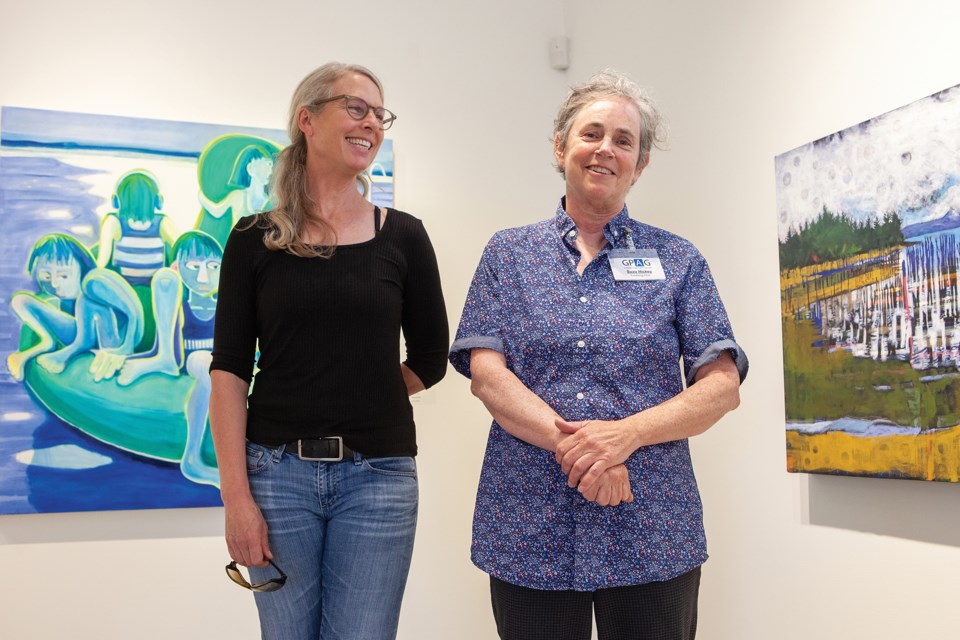Two painters inspired by pandemic-era limitations have created works that explore the idea of distance — both personal and geographical — which are featured at the Gibsons Public Art Gallery this month.
Louise Dee, a British-born and Vancouver-based artist, and Suzo Hickey, who lives in Prince Rupert, met with dozens of guests during an opening reception for their respective exhibitions on Saturday, July 9.
Dee’s oil painting series Public Pool depicts limber-limbed figures adorned in bathing apparel, crowded tightly onto the decks of swimming pools. Bodies flex in unlikely directions, negotiating for space. Swimmers’ paraphernalia fills the gaps: buoyancy rings, pneumatic pumps, towels and goggles. The scenes are languorous; a couple of bathers paddle lazily. The rest incline against one another, skin on skin, with calculated naturalism that evokes the arresting intimacy of Picaso’s Les Demoiselles d’Avignon.
Dee’s original career in physiotherapy provided her with an understanding of anatomy and body kinetics. She pursued studies at Capilano University and Emily Carr University of Art and Design, launching her art career at a group exhibition eight years ago.
“I’ve always had an interest in how the body works and that kind of thing,” Dee said. “I’ve done a lot of still life drawing and realistic figurative drawing. I got to a point where I knew I was still interested in figurative painting but I wasn’t interested in accurate representations. I became more interested in ideas that were broader than capturing specific people.”
Her work on Public Pool began at the beginning of the COVID-19 pandemic, when social distancing rules were put into effect. Grappling with loneliness and separation, Dee searched for a setting rife with human connection. The pool — where strangers strip their clothes and define territorial boundaries with colourful beach towels — fit the bill.
“Everyone’s close [at the pool], especially in Europe where there isn’t as much space,” Dee said. “Somehow in public gatherings when different people come together, the rules are different, but people still understand the rules. I was thinking of how my own experience of going to public places like a market. You don’t necessarily speak to everyone or anyone, but being around people gives you a sense of connection.”
Oversized swans appear in paintings like Untitled (Swan Lake) and I Didn’t Even Ask Her What Music She Likes. For Dee, the avian image was a literal echo of “black swan events” — the once-in-a-century pandemic and social unrest. “I was thinking about the black-and-white of division and separation again,” she said. “And so there are black and white swans that appear as floaties.”
Suzo Hickey’s exhibition of landscapes, Small Fish Big Landscape, arose from freedom she found during initial COVID lockdowns. “Every show I had was cancelled,” she recalled. “All of a sudden you could do whatever you want. You’re not going anywhere, so I thought: what’s around me that I can access?”
Hickey’s acrylic paintings portray timeworn structures in contexts unique to her northern B.C. home. In Port Essington Pilings, the timber uprights that once supported a bustling boardwalk are winnowed to the size and shade of bullrushes. Across From Roosevelt School depicts a web of power distribution lines and transformers suspended from wooden poles that blend into nearby evergreens.
Wilderness and rough-hewn domesticity are comfortable neighbours, as in Picaso’s Underpants, in which starched briefs flap on a laundry line against a distant background of unspoiled forest.
“There’s lots of space up north,” said Hickey. “It’s kind of empty up there, even in the summer. When you drive from Prince Rupert to Terrace, there’s not even another place [between the cities].”
Highways and angular mountain ranges appear frequently in Hickey’s works. She was trained at Emily Carr in the early 1990s, and finds that her style of richly-hued realism has become occasionally infused with unexpected geometric shapes and symmetries.
“My style just keeps evolving and going in new directions,” said Hickey. “It’s just going to keep changing the more you paint, and then you think: well, that really works. If you look at your work chronologically, you can see the colours that you really like. And then it starts to change; you get a new colour. It’s just like the polka dots that started happening [in my paintings] in 2019. I just thought they were so wonderful and fun and you never knew what they’re going to resemble—spots on a windshield, or wild leaves blowing in the wind.”
Public Pool and Small Fish Big Landscape remain at the the Gibsons Public Art Gallery until July 24. The gallery is open every day from 11 a.m. to 4 p.m. Admission is by donation.

-mike-weber.jpg;w=120;h=80;mode=crop)

.jpg;w=120;h=80;mode=crop)